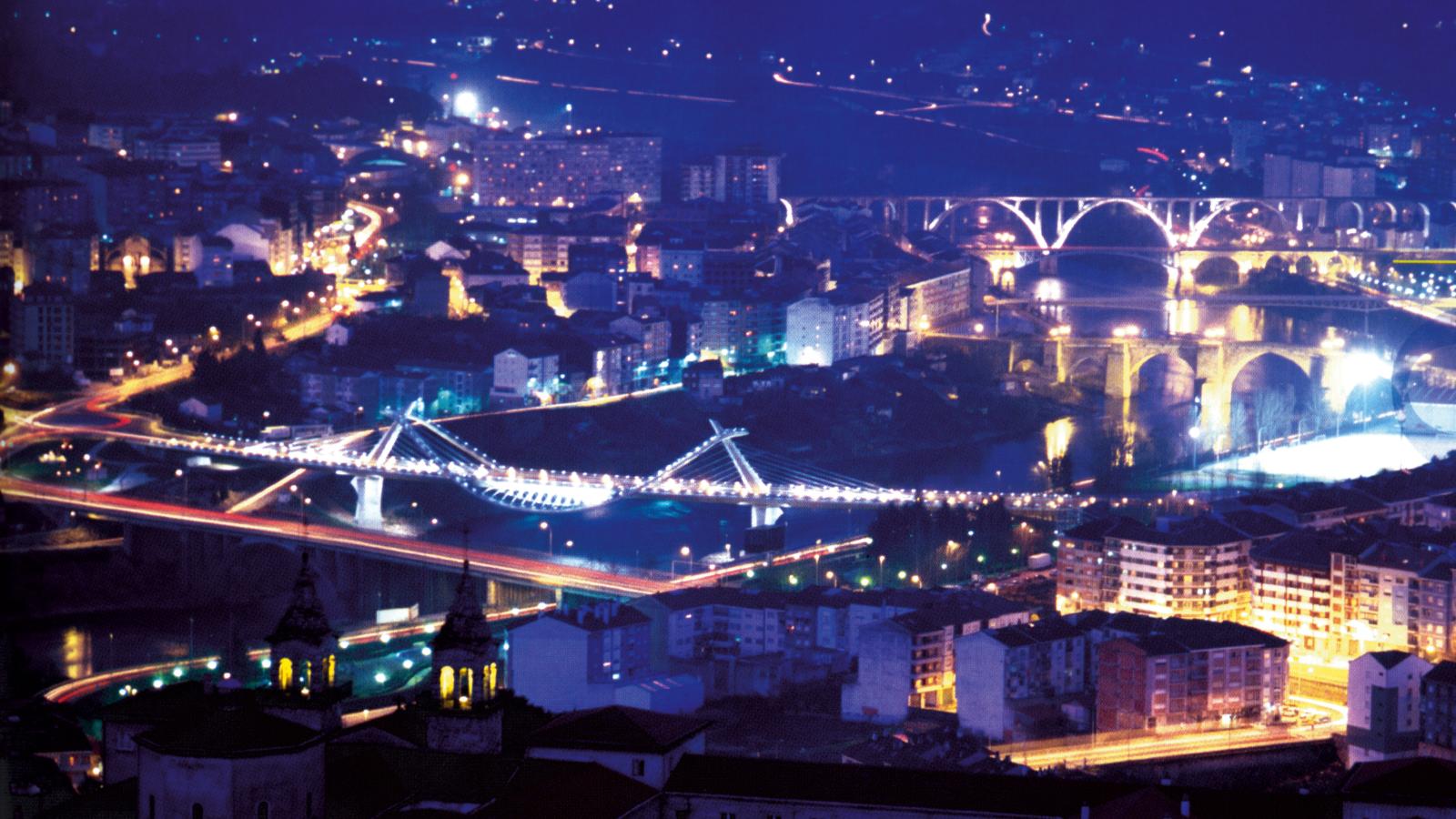We start the visit at As Burgas, birthplace of the city of Ourense, where you can find the famous thermal baths and its thermal pool. Only metres away, it is the Interpretation Centre of As Burgas and the archaeological remains of the ancient roman spa and a sanctuary dedicated to the deities of this waters.
We go up Rúa da Burga and on the left we take Rúa Barreira and we get to the Praza Maior, the nerve centre of the old quarter of the city. In the square there are two important buildings: the Town hall and the old Episcopal palace. If we approach the Baroque façade of the palace, we will find the Church of Santa María at the top of the staircase. From here we get closer to the Cathedral by the Praza da Madalena, a quiet place with a beautiful cross in the centre. We continue along the Praza do Trigo where the Southern gate of the San Martiño Cathedral is. From the square you can access the cathedral. Once inside we will find a Romanesque cathedral with a transition to Gothic. The most important elements inside are: the Paraíso Portico and the gem of the city: the Chapel of Santo Cristo.
Now we walk around the cathedral through the Plaza de Los Suaves (a tribute to this rock group of Ourense), entering the “wines” area. We go through the northern gate of the Cathedral until we get to the Church of Santa Eufemia, which is a typical example of Galician Baroque style.
We continue our way to Rúa Lamas Carvajal, with the Lyceum, the oldest cultural association in the city, situated in a 16th century “pazo” (country house), the Pazo de Oca y Valladares. We turn right at the corner of the Praza Maior until the Alameda, a square that preserves the charm of the Modernist Ourense and close to Abastos local market.
This walk is a basic route in the old part of the city but, if there is time, we recommend you to continue the route. For that, we go back to the Praza Maior, taking Rúa da Barreira and Rúa do Vilar, arriving at the apse of the Trinidad abbey.
DID YOU KNOW THAT?
Opposite to the Church of Santa Eufemia we can find the narrowest house in the city. Look for it, it will not be difficult
A Ponte Vella is represented in city’s coat of arms with a tower demolished in the 19th century
For that, we go back to the Praza Maior, taking Rúa da Barreira and Rúa do Vilar, arriving at the apse of the Trinidad abbey. After the cathedral, it is the most ancient temple in the city. Next to it we find the Posío garden, a nice park which began as a botanical garden.
We return down Rúa Julio Prieto Nespereira until the Praza de San Cosme e San Damián. The name of the square is because of the small Renaissance chapel, where you can see the Arturo Baltar Museum and nativity scene at Christmas. We continue down Rúa Hernán Cortés, which was probably one of the most important streets centuries ago and we arrive in the Praza do Trigo. We go up to the Praza do Correxidor and we continue through Rúa da Estrela, which overlooks the old part of the city and San Francisco Cultural Centre. From here we can see the San Francisco cloister, jewel of Galician gothic and the Escolma de Escultura, the monumental cemetery. It is the resting place of distinguished people of Ourense and contemporary architecture buildings such as the auditorium or the new library. From the Praza do Correxidor we go down towards the Praza do Ferro, with a beautiful fountain in the centre. Down the Rúa Santo Domingo- where the old Dominican monastery church is- we get to the main shopping area, focused on San Lazaro Park and Rúa do Paseo. We arrive Padre Feijoo little gardens, where we can find the Local Tourism Information Office and the
Marcos Valcárcel Cultural Centre, which offers temporary exhibitions and a scale-trains collection. Through Rúa do Progreso we walk until the Ponte Vella (Roman bridge). Crossing the bridge while facing the Paseo termal (Thermal path), we take the opportunity to go up to the “flying” viewpoint over the innovative Milenio bridge. The Thermal path is a walking itinerary of almost four metres of thermal waters on the right side of the Miño river. In addition to the valued fountains of O Tinteiro, this path hosts different thermal baths either free of charge or on a paying basis (A Chavasqueira, Muíño da Veiga, Outariz and Burga de Canedo). You can tour it by walk or on the thermal train that starts from the Praza Maior. If you want to continue walking on the river side, there is a circular route of twelve metres.
In the opposite direction it is located the Archaeological-Natural Site of Santomé (you can access it through a route of four metres from the Ponte Vella by Mende, or by car). This group combines a complex archaeological site (with a fortification and a Galician- Roman settlement) and a indigenous forest, everything marked with explanatory panels. A good family plan is approaching Montealegre Botanic Garden, a fifteen-hectares space which has the farthest north-western Mediterranean forest in Europe. It is complemented with a beautiful view point over Ourense city and a greenhouse with a collection of carnivorous plants. In the way for the smallest of the house it is Os Carrileiros Railway Park, an excellent plan for Sunday morning.
DID YOU KNOW THAT?
Very close to Ourense we found the Ethnographic heritage of Seixalbo, unique Romanesque churches such as Santa Baia de Beiro.
At the Santa Cruz de Arrabaldo railway station it is the Galician traditional suit Museum, as well as the Estanislao Reverter foundation.



* The comments made without logging in will be pending approval prior to publication.